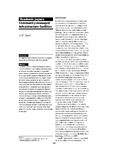| dc.contributor.author | Ngowi, A.B. | |
| dc.date.accessioned | 2008-10-27T10:51:26Z | |
| dc.date.available | 2008-10-27T10:51:26Z | |
| dc.date.issued | 1997 | |
| dc.identifier.citation | Ngowi, A.B. (1997) Community-managed infrastructure facilities, Facilities, Vol.15, No. 12/13, pp. 323-330 | en |
| dc.identifier.issn | 0263-2772 | |
| dc.identifier.uri | http://hdl.handle.net/10311/257 | |
| dc.description.abstract | The design and construction of infrastructure facilities
such as road network, water supply and sewage disposal
in Botswana, have often been done in a top-bottom
fashion where the government or local authority decides
what is good for the community. While the design and
construction of infrastructure facilities require technical
knowledge, heavy equipment and proper supervision,
their management hardly requires these resources to the
same extent. This offers the beneficiaries of the facilities
an opportunity to manage their day-to-day operations
and maintenance. Reports on an approach adopted to
engage the community in the management of local road
network, water supply and sanitation in three major
villages in Botswana. It analyses the method previously
employed in managing these facilities and outlines the
benefits which will accrue when this approach is fully
operational. Concludes by underlining the fact that, for
community-managed facilities to work, the people in the
community need to participate in all the stages of the
project (i.e. planning, design, construction and eventually
maintenance). | en |
| dc.language.iso | en | en |
| dc.publisher | MCB University Press; Emerald Group Publishing Ltd; http://www.emeraldinsight.com/ | en |
| dc.subject | Community-managed | en |
| dc.subject | Infrastructure facility | en |
| dc.subject | Labour-intensive technology | en |
| dc.title | Community-managed infrastructure facilities | en |
| dc.type | Article | en |

